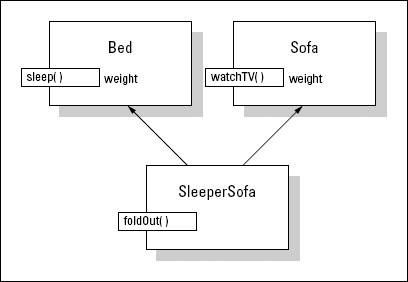Chapter 25. Inheriting Multiple Inheritance
In This Chapter
Introducing multiple inheritance
Avoiding ambiguities with multiple inheritance
Avoiding ambiguities with virtual inheritance
Figuring out the ordering rules for multiple constructors
Getting a handle on problems with multiple inheritance
In the class hierarchies discussed in other chapters, each class inherits from a single parent. Such single inheritance is sufficient to describe most real-world relationships. Some classes, however, represent the blending of two classes into one. (Sounds sort of romantic, doesn't it?)
An example of such a class is the sleeper sofa that integrates a harsh bed into an uncomfortable sofa. To adequately describe a sleeper sofa in C++, the sleeper sofa should be able to inherit both bed- and sofa-like properties. This is called multiple inheritance.
Describing the Multiple Inheritance Mechanism
Figure 25-1 shows the inheritance graph for class SleeperSofa that inherits both from class Sofa and from class Bed.

Figure 25.1. Class hierarchy of a sleeper sofa.
The code to implement class SleeperSofa looks like the following:
// // MultipleInheritance - a single class can inherit from // more than one base class // #include <cstdio> #include <cstdlib> #include <iostream> using namespace std; class Bed { public: Bed(){} void sleep(){ cout << "Sleep" << endl; } int weight; }; class Sofa { public: Sofa(){} void ...Get C++ For Dummies®, 6th Edition now with the O’Reilly learning platform.
O’Reilly members experience books, live events, courses curated by job role, and more from O’Reilly and nearly 200 top publishers.

